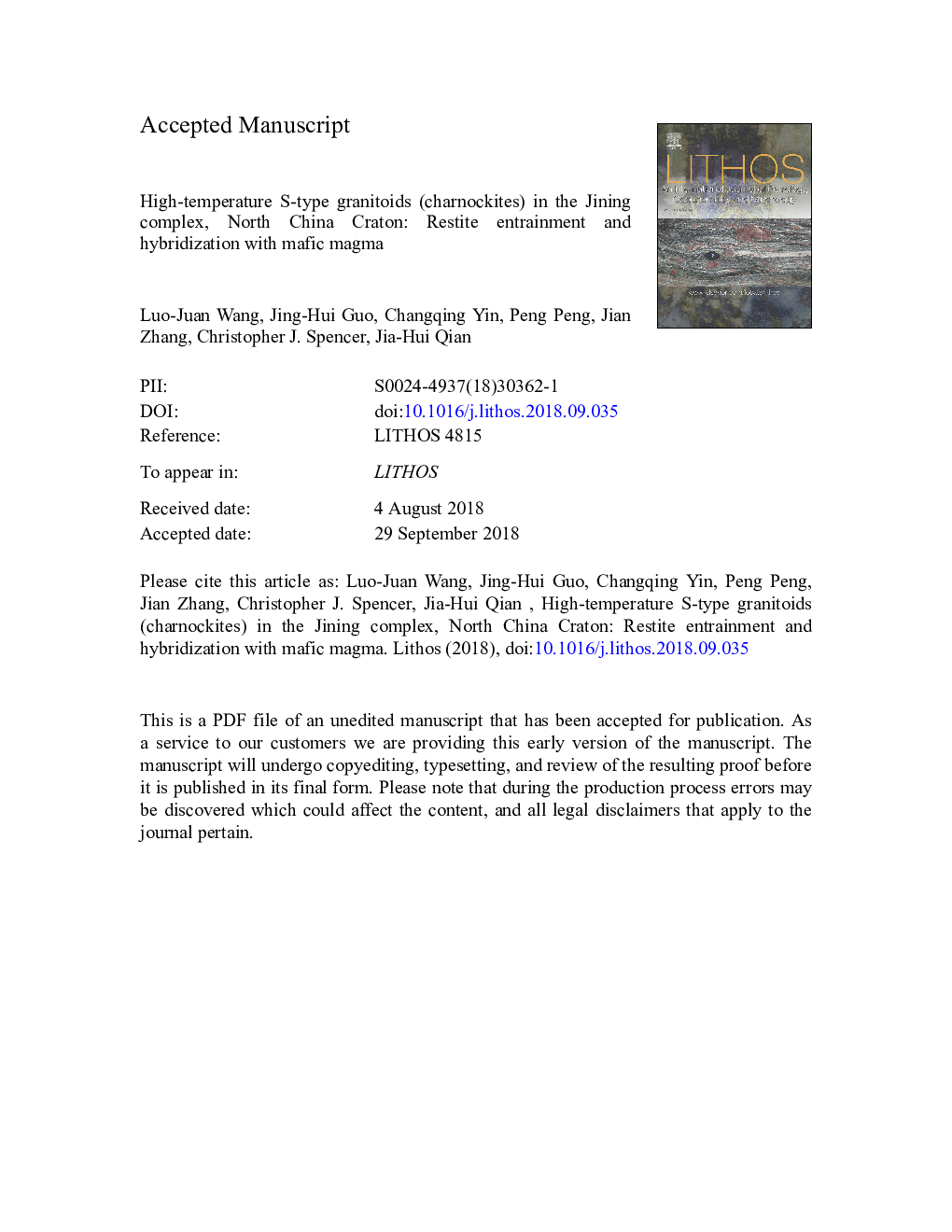| کد مقاله | کد نشریه | سال انتشار | مقاله انگلیسی | نسخه تمام متن |
|---|---|---|---|---|
| 11024652 | 1701099 | 2018 | 69 صفحه PDF | دانلود رایگان |
عنوان انگلیسی مقاله ISI
High-temperature S-type granitoids (charnockites) in the Jining complex, North China Craton: Restite entrainment and hybridization with mafic magma
دانلود مقاله + سفارش ترجمه
دانلود مقاله ISI انگلیسی
رایگان برای ایرانیان
موضوعات مرتبط
مهندسی و علوم پایه
علوم زمین و سیارات
ژئوشیمی و پترولوژی
پیش نمایش صفحه اول مقاله

چکیده انگلیسی
The Liangcheng garnet granitoids are parautochthonous S-type granites that occur within granulite-facies metasediments in the ultrahigh-temperature (UHT) Jining Complex, eastern part of the Khondalite Belt, North China Craton. These garnet granitoids contain mafic microgranular enclaves and are intimately associated with numerous small intrusions of the Xuwujia gabbronorites, showing magma mingling and mixing textures. Typical mineralogy in the garnet granitoids is plagioclase + K-feldspar + quartz + garnet + biotite ± orthopyroxene. UPb ion microprobe dating of zircon suggests that garnet granitoids and associated gabbronorites were coeval with UHT metamorphism at ~1.93-1.92â¯Ga, and also recorded ~1.92â¯Ga metamorphism during slow cooling. Garnet granitoids are characterized by the presence of orthopyroxene, high modal proportion of garnet (up to 25%) and strongly peraluminous (ASIâ¯=â¯1.11-1.55) along with lower SiO2 (57.8-70.1â¯wt%) and higher FeOtâ¯+â¯MgO (5.6-14.4â¯wt%) contents than typical S-type granites. Mineral chemistry (high Ti biotite and high Al orthopyroxene), high Al-in-orthopyroxene temperature (910-989â¯Â°C) and Zr saturation temperature (825-901â¯Â°C), and low whole-rock Al2O3/TiO2 ratios (11-28), indicate that garnet granitoids were derived from biotite dehydration melting of metasedimentary rocks under UHT granulite-facies conditions. Textural and compositional evidence suggests that a significant proportion of garnets in the Liangcheng garnet granitoids are potentially a peritectic phase entrained from the source. Garnet aggregates may also represent entrained garnet-rich restites. The large HREE variations of garnet granitoids also support the entrainment of garnet-rich restites. Garnet granitoids display nearly linear trends with the mafic enclaves and gabbronorite for most major elements that demonstrates the involvement of mafic magma in the granitoid petrogenesis. The εHf(t) values (â1.0â¯ââ¯+5.6) and δ18O values (9.2-11.6â°) of zircons in garnet granitoids partly overlap with those in gabbronorites (εHf(t)â¯=â¯â2.9â¯ââ¯+3.5, δ18Oâ¯=â¯7.7-10.9â°), suggesting the strong interaction and mixing process between them. Major element modelling suggests that the addition of 20-40% restites (garnetites) and gabbronorites to the anatectic melts was responsible for the large chemical variations. Therefore, the Liangcheng garnet granitoids represent high-temperature (> 900â¯Â°C), H2O-undersaturated, strongly peraluminous granitoids, and are produced by large-scale melting of metasedimentary rocks and subsequent mixing between restite-rich anatectic melt and mafic magma. The voluminous high-temperature granitoids, coupled with UHT granulites in the Jining Complex, manifest the thermal response of a granulitic lower crust to the mafic underplating.
ناشر
Database: Elsevier - ScienceDirect (ساینس دایرکت)
Journal: Lithos - Volumes 320â321, November 2018, Pages 435-453
Journal: Lithos - Volumes 320â321, November 2018, Pages 435-453
نویسندگان
Luo-Juan Wang, Jing-Hui Guo, Changqing Yin, Peng Peng, Jian Zhang, Christopher J. Spencer, Jia-Hui Qian,